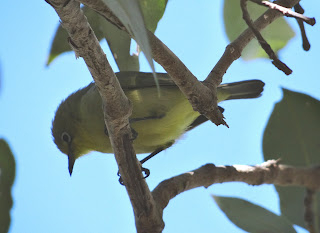Following on from my
Black Grasswren post, pictures and notes follow on other birds seen during the trip that Alexander Watson and I did through the Western Kimberleys this month.
We camped at and birded four sites - Mitchell River National Park (where the grasswrens were; see grasswren post following), Drysdale River Station (on the Kalumburu Road, 60 kilometres north of its junction with the Gibb River Road), Miner's Pool (a lovely site on the Drysdale River a few kilometres north of Drysdale River Station) and Silent Grove (20 kilometres north of the Gibb River Road, the turnoff being a few kilometres west of Imintji).
The distinctive Kimberley race of the Partridge Pigeon with its yellow face (image above) was seen regularly feeding about the Mitchell River camping ground.
Another bird found regularly in Mitchell River National Park was the White-quilled Rock-Pigeon, common about the sandstone scarps.
Long-tailed Finch was regular around the Mitchell River camping ground, and was found throughout the trip in open woodland.
This pair of Torresian Imperial-Pigeons were in riverside vegetation above Little Mertens Falls at Mitchell River.
Buff-sided Robin, a recent split from White-browed Robin in eastern Australia, is another sought after species. This one was in a monsoon forest thicket below Little Mertens Falls. Another pair were found along track between Little and Big Mertens Falls.
Bar-breasted Honeyeater was common at Mitchell River and encountered regularly elsewhere on the trip.
The Kimberley Honeyeater is a recent taxonomic split, from the White-lined Honeyeater of Arnhem Land. This was one of several that we encountered while looking for Black Grasswren at Mitchell River.
Green-backed Gerygones were active in thickets along the Mitchell River.
Silver-crowned Friarbird was commonly found in open woodland throughout the trip, this one in the Mitchell River camping ground.
Red-winged Parrot was also regularly encountered, this female at Drysdale River Station.
We looked hard but without success for Red Goshawk, seeing plenty of Brown Goshawks and, at Mitchell River, this Collared Sparrowhawk.
Among other raptors was this Wedge-tailed Eagle feeding on a road-killed dingo on the Gibb River Road.
Blue-winged Kookaburra was frequently seen, this one at Miner's Pool.
Lilac-crowned Fairy-wrens appeared to be quite numerous in Pandanus thickets along the Drysdale River at Miner's Pool, but were typically furtive. This male put in a brief appearance. Another much sought after species.
Birds seen around Silent Grove and Bell Gorge included plenty of Crimson Finches.
The only Northern Rosellas we saw were near Silent Grove.
This Banded Honeyeater was at Silent Grove, but the species was encountered in various places.
Yellow-tinted Honeyeater was probably the commonest bird of the trip.




















































